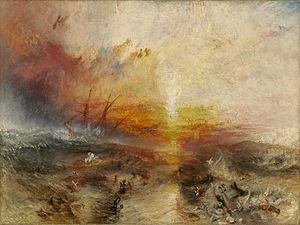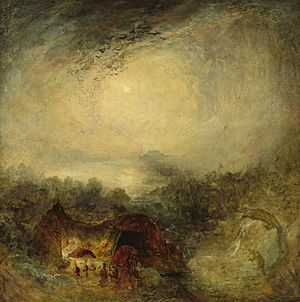The Slave Ship facts for kids
Quick facts for kids The Slave Ship |
|
|---|---|
| Slavers Throwing overboard the Dead and Dying—Typhon coming on | |
 |
|
| Artist | J. M. W. Turner |
| Year | 1840 |
| Medium | Oil on canvas |
| Dimensions | 91 cm × 123 cm (36 in × 48 in) |
| Location | Museum of Fine Arts, Boston |
The Slave Ship, originally titled Slavers Throwing overboard the Dead and Dying—Typhon coming on, is a painting by the British artist J. M. W. Turner, first exhibited at The Royal Academy of Arts in 1840.
Measuring 35+3⁄4 in × 48+1⁄4 in (91 cm × 123 cm) in oil on canvas, it is now on display at the Museum of Fine Arts, Boston. In this classic example of a Romantic maritime painting, Turner depicts a ship visible in the background, sailing through a tumultuous sea of churning water and leaving scattered human forms floating in its wake. Turner was possibly moved to paint The Slave Ship after reading about the slave ship Zong in The History and Abolition of the Slave Trade by Thomas Clarkson the second edition of which was published in 1839. The initial exhibition of the painting in 1840 coincided with international abolitionist campaigns. As the piece changed hands in subsequent years, it was subject to a wide array of conflicting interpretations. While the work is generally admired for its spectacular atmospheric effects, there are conflicting opinions about the relationship between its style and its subject matter.
Contents
Background
Historical background
In 1781, the captain of a slave ship inbound to Jamaica, the Zong, had ordered 132 slaves to be thrown overboard when drinking water was running low so that insurance payments could be collected; slaves who died of natural causes were not covered by insurance. This incident went to court, and the trial that ensued gained wide public attention, building support for the abolition of slavery. Although the trial was deemed to be inconclusive, it was a pivotal catalyst in the movement towards British abolition and a moment that later inspired Turner to portray the incident in The Slave Ship.
While the first organized British abolition movement was started in 1727, the slave trade in the British Empire was not officially abolished until 1807 with slavery itself abolished in 1833. Universal abolition was then at the center of politics following Britain's reform. Motives for the movement were centrally humanitarian, but economic incentives also incited a desire to terminate this commercial act in competing countries.
J. M. W. Turner
J.M.W. Turner was a well-known 19th-century landscape painter born in London in 1775, who was highly regarded for his stylistic innovation. His training in the arts was extensive. He started studying at the Royal Academy at the age of fourteen, and gained additional experience in topographical drawings and watercolor working under Dr. Thomas Monro, a physician and alienist, developing his interest in landscapes and distinctive application of colors.
Due to his liberal beliefs and interest in current events, Turner was directly exposed to the campaigns and publications of the anti-slavery societies of his time, the Society for the Mitigation and Gradual Abolition of Slavery Throughout the British Dominions (1823–1838) and the British and Foreign Anti-Slavery Society (founded 1839), which inevitably shaped his abolitionist beliefs. As an abolitionist, Turner was passionate about contributing to the slavery resistance campaigns in international regions, such as in the United States. The first documented sign of Turner's artistic contribution to the anti-slavery movement occurred in 1828 when he dedicated an engraving of his painting The Deluge to a well known abolitionist, John Joshua Proby. Twelve years later, after possibly being informed about the Zong incident from reading The History and Abolition of the Slave Trade by Thomas Clarkson, as well as the Amistad rebellion and subsequent court case in the United States which was international news, Turner was inspired to depict these horrific events in his piece The Slave Ship.
Exhibition at The Royal Academy of Arts
In 1840, two important international anti-slavery conventions were held in London: "The General Anti-Slavery Society" and "Society of the Extinction of the Slave Trade and the Civilization of Africa." Turner's exhibition of The Slave Ship at the Royal Academy of Arts coincided with these conventions. This public display of a horrific event reminding viewers of Britain's past was intended to evoke an emotional response to the inhumane slave trade still occurring at that time in other parts of the world. Given the context of its initial exhibition, the painting would likely have been interpreted as a political call to action.
When Turner exhibited this picture at the Royal Academy of Arts in 1840 he paired it with the following extract from his unfinished and unpublished poem Fallacies of Hope (1812):
-
- "Aloft all hands, strike the top-masts and belay;
- Yon angry setting sun and fierce-edged clouds
- Declare the Typhon's coming.
- Before it sweeps your decks, throw overboard
- The dead and dying – ne'er heed their chains
- Hope, Hope, fallacious Hope!
- Where is thy market now?"
Description
Subject matter
The first impression that the painting creates is of an enormous deep-red sunset over a stormy sea, an indication of an approaching typhoon. This ominous typhoon is further indicated by an approaching dramatized storm cloud, creeping into the visible space from the left, with its rich colors sprawling towards an unstained sky. Upon closer inspection one can discern a ship sailing off into the distance. This ship is identifiable as a type of fast vessel used by slavers to escape navy patrollers, characterized by its "low, lean lines and clipper bow." The masts of the ship are red, matching the blood-red color of the sky and the sickly copper color of the water, which serves to blur the lines between various objects in the painting. The ship's sails are furled, revealing that it is preparing for the typhoon.
In the right corner of the foreground, a single dark-skinned leg juts out of the water with an iron chain locked around its ankle. ..... A chaotic swarm of seagulls and fish surrounds the leg, as though they are consuming the woman; one fish, in particular, is shown approaching the frenzy with its mouth wide open. This violence is enhanced by spare red blotches around the head of the fish, indicating blood. Smaller dark limbs project from the stormy seas on the left, surrounded by loose chains, alluding to the numerous other slaves who were thrown off the ship and left to drown. Tails of fish swimming in the water around the drowning slaves can be observed, augmenting the scene's turmoil.
Artistic style
Consistent with Turner's emphasis on color in many of his other works, the painting's central focus is on the interactions of various colors. Few defined brush strokes appear in the painting, and objects, colors, and figures become indistinct. Objects are defined by colors rather than distinct lines, and some objects, like the human bodies in the water and the incoming storm, having no real border at all are solely defined by the contrast with the pigments around them. The most prominent colors are the red of the sunset, which encroaches into the water and ship, and the maroon of the bodies and hands of the slaves. This approach is characteristic of Turner's painterly style, in which he commonly exaggerates colors and omits details to make forms more fluid and sensational, eliciting an emotional response from the viewer. At the pinnacle of his career, Turner's style minimized the elements of a landscape and abstracted details through indistinct forms and colors.
Legacy
In 2006 the painting was the focus of episode 5 in the eight-part BBC TV mini-series Simon Schama's Power of Art, broadcast by BBC Two.
See also
- List of paintings by J. M. W. Turner


